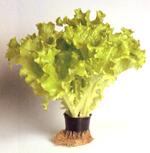| Fruits |
Vegetables
|
Lettuce, Lactuca sativa / Compositae
|
Note: Composition for 100 g. of fresh product Values in ( min. - max. ) format. | |
| Energy: 11.61-14.00 kcal Fats: 0.20-0.50 g Fibres: 0.90-1.44 g Fat Acids Saturated: 0.10-0.10 gPolyunsat.: 0.30-0.30 g Minerals Calcium: 20.44-70.00 mgZinc: 0.200-0.380 mg Chlorine: 47.00-57.00 mg Phosporus: 22.42-46.00 mg Iron: 0.336-1.50 mg Magnesium: 6.00-22.00 mg Manganese: 0.176-0.304 mg Potasium: 172.08-413.00 mg Selenium: 0.413-1.00 µg Sodium: 3.00-33.00 mg Iodine: 2.00-3.14 µg | Proteins: 0.80-1.80 kcal Carbohidrates: 0.80-1.70 g Liposoluble Vitamins A Retinol: 0.00-239.50 µgA Carotenoids: 355.00-1440.00 µg E or Tocoferol: 0.570-0.907 mg K or Filoquinone: 1300.00-1300.00 µg Liposoluble Vitamins B1 or Thiamine: 0.057-0.120 mgB2 or Riboflavine: 0.015-0.078 mg B3 or Niacine: 0.40-1.10 mg B5 or Pantothenic Acid: 0.110-0.180 mg B6 or Piridoxine: 0.040-0.057 mg B9 or Folic Acid: 4.00-13.00 mg C or Ascorbic Acid: 4.00-13.00 mg |

The lettuce is a very popular vegetable which is cultivated for its large leaves; in some cases, these are pressed forming more or less compact core or heart. There are many varieties of this vegetable, and their number increases every year. The nutritious properties of this plant are scarce, although it is low in calories and supplies some vitamins and minerals.
Nutrition and eating
The lettuce has been given tranquillizer and sedative properties for many centuries. Moreover, it is used to treat constipation and exhaustion, and it is a diuretic vegetable.
The fruit
 The lettuce is a very popular vegetable which is cultivated for its large leaves; in some cases, these are pressed forming more or less compact core or heart. There are many varieties of this vegetable, and their number increases every year. The nutritious properties of this plant are scarce, although it is low in calories and supplies some vitamins and minerals.
The lettuce is a very popular vegetable which is cultivated for its large leaves; in some cases, these are pressed forming more or less compact core or heart. There are many varieties of this vegetable, and their number increases every year. The nutritious properties of this plant are scarce, although it is low in calories and supplies some vitamins and minerals.The lettuce is composed of large overlapped leaves, forming in some cases a sprouting. There are lettuces of different shape, size and colour, either green or red. They may have more or less sawed leaves.
There are many doubts on their origin, although it is known that they were already well-known by the old civilisations. The Romans spread their culture all over the rest of Europe.
There exist multiple varieties of lettuce and every year some new ones are obtained, offering significant improvements as far as production, shape of the heart or resistance to diseases. Some of the most known types are the Roman lettuces, Iceberg, trocadero, etc. New groups like the baby lettuces or the red lettuces have also appeared in the market.
The lettuce is eaten raw, in salads together with tomato and onion, among some other ingredients. It can also be eaten cooked or roasted, although less frequently. It is also consumed in vegetable stews.
It has a low content of nutrients and fat, making it recommendable in slimming diets. It gives some vitamins, like vitamin C and folic acid, and small quantities of phosphorus, potassium, iron and calcium. It is considered to have tranquillizer and sedative properties.
The plant

The lettuce is an annual plant; at the beginning, it forms a rosette of leaves that usually gives rise to a heart of tight leaves. Afterwards, the heart opens and appears the stem, on which the flowers of yellow colour grow.
The lettuce belongs to the family of Compositae (Composites); its scientific name is Lactuca sativa. It has a deep and scarcely branched root system. At first, when the plant sprouts, the leaves are arranged forming a rosette. While the plant grows, the leaves are pressed one against the others, forming a more or less consistent and compact heart, depending on the variety. The leaves may be rounded or somewhat slender. The edge can be even, curled or sawed.
The plant is usually harvested in the heart stage. However, if it is not harvested, the leaves open and there appears a cylindrical and branched stem with leaves and yellowish flowers grouped in clusters. What we know as the seed is, in fact, the fruit, which is small, with tiny small feathers that facilitate their distribution, thanks to the wind.
The lettuce belongs to the family of Compositae (Composites); its scientific name is Lactuca sativa. It has a deep and scarcely branched root system. At first, when the plant sprouts, the leaves are arranged forming a rosette. While the plant grows, the leaves are pressed one against the others, forming a more or less consistent and compact heart, depending on the variety. The leaves may be rounded or somewhat slender. The edge can be even, curled or sawed.
The plant is usually harvested in the heart stage. However, if it is not harvested, the leaves open and there appears a cylindrical and branched stem with leaves and yellowish flowers grouped in clusters. What we know as the seed is, in fact, the fruit, which is small, with tiny small feathers that facilitate their distribution, thanks to the wind.
Tricks and tips
Dressing a salad
Lettuce salads will keep better if they are dressed just before serving
Trimming the lettuce
Withered leaves are refreshed by soaking them a few minutes in hot water and later washing them with cold water
| Interempresas Media, S.L. / 2025 | [ Legal notice | Política de Protección de Datos | Política de cookies | Publicidad] |
